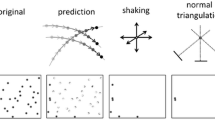Abstract
The spatial resolution of the PIV interrogation technique is discussed from an analytical standpoint and assessed with Monte Carlo numerical simulation of particle image motion. The PIV measurement error associated with lack of spatial resolution is modelled associating the cross-correlation operator to a moving average filter. The error associated with the "low-pass filtering" effect is investigated by adopting a second-order polynomial expression for the velocity spatial distribution. According to the present error analysis, the measurement error is proportional to the second-order spatial derivative of the velocity field and increases with the square of the window linear size. The strategy for the selection of the window size and properties (aspect ratio and orientation) so as to minimize the error is discussed. The principle is based on nonisotropic interrogation windows of elliptical shape, with a constant area and elongated in the direction of the largest curvature radius. The nonisotropic parameters are defined as eccentricity and orientation, which are based on the local eigenvalues/vectors of the Hessian tensor of the displacement spatial distribution. The technique is implemented in a recursive PIV interrogation method. The performance of nonisotropic interrogation technique is assessed by means of synthetic PIV images, which simulate three situations: first, a one-dimensional sinusoidal shear displacement, which allows comparison of the cross-correlation spatial response with the transfer function of linear filters. Second, the stream-wise exponential velocity decay is simulated, which simulates the particle tracers decelerating downstream of a shock wave and gives an example of a flow with main velocity differences aligned with the velocity direction. The results show that keeping the image density fixed, the error caused by insufficient spatial resolution can be reduced by a factor two when a preferential direction is found in the flow field. Finally, a Lamb–Oseen vortex flow is presented, which shows the complex pattern formed by the interrogation windows in a two-dimensional case. In this case, the improvement in interrogation performance is limited due to the isotropic nature of the velocity spatial fluctuation.











Similar content being viewed by others
References
Adrian RJ, Yao CS (1985) Pulsed laser technique application to liquid and gaseous flows and the scattering power of seed materials. Appl Opt 24:44–52
Di Florio D, Di Felice F, Romano GP (2002) Windowing, re-shaping and re-orientation interrogation windows in particle image velocimetry for the investigation of shear flows. Meas Sci Technol 13:953–962
Fincham AM, Delerce G (2000) Advanced optimization of correlation imaging velocimetry algorithms. Exp Fluids 29:S013–22
Fincham AM, Spedding GR (1997) Low cost, high resolution DPIV for measurement of turbulent fluid flow. Exp Fluids 23:449–462
Gui L, Merzkirch W, Fei R (2000) A digital mask technique for reducing the bias error of the correlation-based PIV interrogation algorithm. Exp Fluids 29:30–5
Huang HT, Fielder HF, Wang JJ (1993a) Limitation and improvement of PIV. 1. Limitation of conventional techniques due to deformation of particle image patterns. Exp Fluids 15:168–174
Huang HT, Fielder HF, Wang JJ (1993b) Limitation and improvement of PIV. 2. Particle image distortion, a novel technique. Exp Fluids 15:263–273
Keane RD, Adrian RJ (1993) Theory of cross-correlation analysis of PIV images. In: Nieuwstadt FTM (ed) Flow visualisation and image analysis. Kluwer, Dordrecht, pp 1–25
Lecordier B (1997) Etude de l'interaction de la propagation d'une flamme premelangee avec le champ aerodynamique, par association de la tomographie Laser et de la Velocimetrie par Images de particules. Dissertation, Universite de Rouen, France
Nogueira J, Lecuona A, Rodriguez PA (1999) Local field correction PIV: on the increase of accuracy of digital PIV systems. Exp Fluids 27:107–116
Nogueira J, Lecuona A, Ruiz-Rivas U, Rodríguez PA (2002) Analysis and alternatives in two-dimensional multigrid particle image velocimetry methods: application of a dedicated weighting function and symmetric direct correlation. Meas Sci Technol 13:963–974
Raffel M, Willert CE, Kompenhans J (1998) Particle image velocimetry, a practical guide. Springer, Berlin Heidelberg New York
Scarano F (2002) Iterative image deformation methods in PIV. Meas Sci Technol 13:R1–R19
Scarano F, Riethmuller ML (1999) Iterative multigrid approach in PIV image processing. Exp Fluids 26:513–523
Scarano F, Riethmuller ML (2000) Advances in iterative multigrid PIV image processing. Exp Fluids 29:S051–60
Westeerweel J (1993) Digital particle image velocimetry. Dissertation, Delf University Press, Delft
Westeerweel J, Dabiri D, Gharib M (1997) The effect of a discrete window offset on the accuracy of cross-correlation analysis of digital PIV recordings. Exp Fluids 23:20–28
Willert CE, Gharib M (1991) Digital particle image velocimetry. Exp Fluids 10:181–193
Author information
Authors and Affiliations
Corresponding author
Rights and permissions
About this article
Cite this article
Scarano, F. Theory of non-isotropic spatial resolution in PIV. Exp Fluids 35, 268–277 (2003). https://doi.org/10.1007/s00348-003-0655-4
Received:
Accepted:
Published:
Issue Date:
DOI: https://doi.org/10.1007/s00348-003-0655-4




